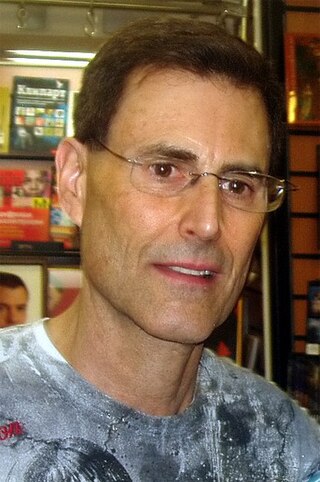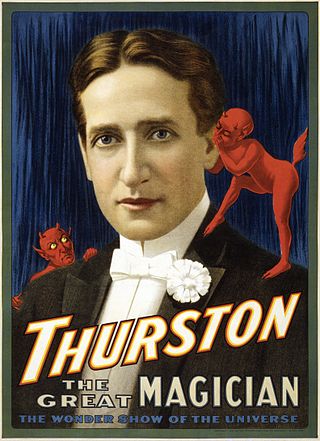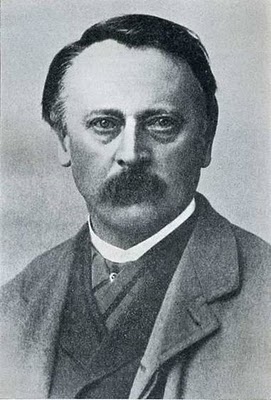
A grimoire is a textbook of magic, typically including instructions on how to create magical objects like talismans and amulets, how to perform magical spells, charms, and divination, and how to summon or invoke supernatural entities such as angels, spirits, deities, and demons. In many cases, the books themselves are believed to be imbued with magical powers. The only contents found in a grimoire would be information on spells, rituals, the preparation of magical tools, and lists of ingredients and their magical correspondences. In this manner, while all books on magic could be thought of as grimoires, not all magical books should be thought of as grimoires.

James Randi was a Canadian-American stage magician, author, and scientific skeptic who extensively challenged paranormal and pseudoscientific claims. He was the co-founder of the Committee for Skeptical Inquiry (CSI), and founder of the James Randi Educational Foundation (JREF). Randi began his career as a magician under the stage name The Amazing Randi and later chose to devote most of his time to investigating paranormal, occult, and supernatural claims. Randi retired from practicing magic at age 60, and from his foundation at 87.

Rosicrucianism is a spiritual and cultural movement that arose in early modern Europe in the early 17th century after the publication of several texts announcing to the world a new esoteric order. Rosicrucianism is symbolized by the Rose Cross or Rosy Cross. There have been several Rosicrucian organizations since the initial movement was founded, including the Order of the Golden and Rosy Cross (1750s–1790s), the Societas Rosicruciana in Anglia (1865–present), and the Hermetic Order of the Golden Dawn (1887–1903).

Uri Geller is an Israeli-British illusionist, magician, television personality, and self-proclaimed psychic. He is known for his trademark television performances of spoon bending and other illusions. Geller uses conjuring tricks to simulate the effects of psychokinesis and telepathy. Geller's career as an entertainer has spanned more than four decades, with television shows and appearances in many countries. Magicians have called Geller a fraud because of his claims of possessing psychic powers.

Frederick William II was King of Prussia from 1786 until his death in 1797. He was in personal union with the prince-elector of Brandenburg and sovereign prince of the Canton of Neuchâtel. As a defensive reaction to the French Revolution, Frederick William II ended the German Dualism between Prussia and Austria. Domestically, he turned away from the enlightened style of government of his predecessor and introduced a tightened system of censorship and religious control. The king was an important patron of the arts especially in the field of music. As a skilled cellist he enjoyed the dedication of various cello-centric compositions by composers Mozart, Haydn, Boccherini, and Beethoven. He was also responsible for some of the most notable architecture in Prussia, including the Brandenburg Gate in Berlin, the Marble Palace, and Orangery in the New Garden, Potsdam.

Paschal Beverly Randolph was an American medical doctor, occultist, spiritualist, trance medium, and writer. He is notable as perhaps the first person to introduce the principles of erotic alchemy to North America, and, according to A. E. Waite, establishing the earliest known Rosicrucian order in the United States.

Reuben Swinburne Clymer was an American occultist and modern Rosicrucian Supreme Grand Master of the FRC, perhaps the oldest continuing Rosicrucian organization in the Americas. He practiced alternative medicine, and wrote and published works on it as well as the teachings of Paschal Beverly Randolph (1825-1875), alchemy, nutrition, religion, sex magic and spiritualism. This led to a number of conflicts with Harvey Spencer Lewis (1883-1939) and the AMORC, FUDOSI, Aleister Crowley, and even the American Medical Association.

Georg Christoph Lichtenberg was a German physicist, satirist, and Anglophile. He was the first person in Germany to hold a professorship explicitly dedicated to experimental physics. He is remembered for his posthumously published notebooks, which he himself called Sudelbücher, a description modelled on the English bookkeeping term "waste books" or "scrapbooks", and for his discovery of the tree-like electrical discharge patterns now called Lichtenberg figures.

Abraham Abramson was a Prussian coiner and medallist. Born into a Jewish family, he later converted to Protestantism.

Howard Thurston was a stage magician from Columbus, Ohio, United States. As a child, he ran away to join the circus, where his future partner Harry Kellar also performed. Thurston was deeply impressed after he attended magician Alexander Herrmann's magic show and was determined to equal his work. Alexander Herrmann was a french magician and was known as "Herrmann the Great". Thurston eventually became the most famous magician of his time. Thurston's traveling magic show was the biggest one of all; it was so large that it needed eight train cars to transport his road show.

Milbourne Christopher was a prominent American illusionist, magic historian, and author.

Franz Hartmann was a German medical doctor, theosophist, occultist, geomancer, astrologer, and author.
The Cipher Manuscripts are a collection of 60 folios containing the structural outline of a series of magical initiation rituals corresponding to the spiritual elements of Earth, Air, Water and Fire. The "occult" materials in the Manuscripts are a compendium of the classical magical theory and symbolism known in the Western world up until the middle of the 19th century, combined to create an encompassing model of the Western mystery tradition, and arranged into a syllabus of a graded course of instruction in magical symbolism. It was used as the structure for the Hermetic Order of the Golden Dawn, after the manuscripts came into the possession of prominent SRIA members.
Lichtenberg's Avertissement, written by Georg Christoph Lichtenberg, is a poster intended to deter the citizens of Göttingen, Germany, from attending the performance of Jacob Philadelphia in 1777. The performance was supposed to be an exhibition of scientific experiments; however, Lichtenberg considered it to be a magic show. He was angered by the alleged deception and posted the following satire in order to persuade people to avoid the performance. As a result of the extravagant claims that were posted, Philadelphia left Göttingen without giving any exhibitions.

Stanislas de Guaita was a French poet based in Paris, an expert on esotericism and European mysticism, and an active member of the Rosicrucian Order. He was very celebrated and successful in his time. He had many disputes with other people who were involved with occultism and magic. Occultism and magic were part of his novels.

An Encyclopedia of Claims, Frauds, and Hoaxes of the Occult and Supernatural is a 1995 book by the conjuror and paranormal investigator James Randi, with a foreword by Arthur C. Clarke. It serves as a reference for a variety of topics within pseudoscience, the paranormal, and hoaxes. The Encyclopedia received generally positive reviews. In 2006, Randi made the work available free online.

Magic, which encompasses the subgenres of illusion, stage magic, and close-up magic, among others, is a performing art in which audiences are entertained by tricks, effects, or illusions of seemingly impossible feats, using natural means. It is to be distinguished from paranormal magic which are effects claimed to be created through supernatural means. It is one of the oldest performing arts in the world.

Frederick Hockley was a British occultist and scryer who was a London-based Freemason and a member of the Societas Rosicruciana in Anglia.

Johann Christoph von Wöllner was a Prussian pastor and politician under King Frederick William II. He was inclined to mysticism and joined the Freemasons and the Order of the Golden and Rosy Cross.


















